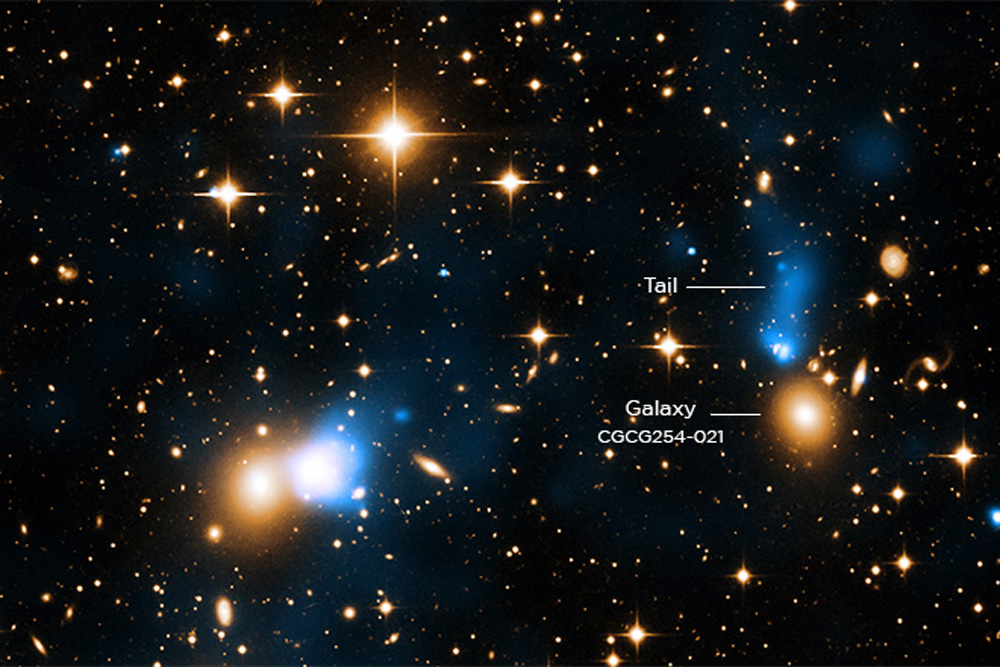Galaxy Grows Monstrous X-Ray Tail

In a galactic cluster far, far away, a galaxy has grown an unprecedented tail of super-heated gases, providing astronomers with a unique glimpse of an extreme intragalactic environment.
PHOTO: Violent Galaxy Cluster Smash Spawns Weird Radio Wiggle
Using the X-ray vision of NASA’s Chandra space telescope, the ghostly glow of a 250,000 light-year long tail has been seen streaming from a galaxy called CGCG254-021 deep inside the Zwicky 8338 cluster nearly 700 million light-years from Earth. This tail, a stream of superheated interstellar gases, has been ripped from the galaxy as it interacts with the hotter intragalactic gases inside the cluster.
The temperature of the tail gases has been gauged at around 10 million degrees Kelvin (Celsius), whereas the intragalactic gases in Zwicky 8338 are 3 times hotter.
Of most interest is the gap between the tail and the galaxy, a possible indication that all the available star-forming gases inside the galaxy has been blown away and depleted.
ANALYSIS: Monster Black Hole Belches Record Flare
“The large separation between the galaxy and the tail might be telling us that the gas has been completely stripped off the galaxy,” said Thomas Reiprich, University of Bonn in Germany. “In effect, the tail has been cut off from the galaxy.”
Get the Space.com Newsletter
Breaking space news, the latest updates on rocket launches, skywatching events and more!
Astronomers speculate that the galaxy’s loss may be the cluster’s gain; this tail of gas, that extends over twice the width of our galaxy, could spawn an island of star formation all by itself. Infrared studies of CGCG254-021 have shown that there is very little active star formation underway, likely a symptom of the massive gas loss that formed the tail.
Other characteristics of the tail gases have been studied, including the higher concentration of heavier elements (than helium) in the “head” of the tail (the brighter, cooler blob nearest its parent galaxy). There’s also evidence of a bow shock leading the tail — both galaxy and tail are known to be traveling downward in this observation. The shock is generated by this supersonic motion through the cluster’s intragalactic medium.
ANALYSIS: Super-Dense Galaxy a Victim of Stellar Robbery?
“This tail is a vivid example of how dynamic galaxy clusters are, as we may be seeing the transformation of a galaxy as it moves through the cluster,” said Gerrit Schellenberger of the University of Bonn in Germany, who led the study that is published in the November edition of the journal Astronomy and Astrophysics. “Also, the material in the tail includes not only hydrogen but heavier elements, and could spawn a new generation of stars trailing behind the galaxy.”
Galaxy clusters are of huge interest as they are so massive. Often containing hundreds to thousands of individual galaxies, this vast structures are islands of intense gravitational dominance over space-time and known to be reservoirs of dark matter — the invisible stuff that makes up around 85 percent of all mass in the universe. By looking deep into these clusters we can better understand how individual galaxies evolve.
“Since galaxy clusters are so enormous, they play a critical role in understanding how our Universe evolves,” added Schellenberger. “To understand galaxy clusters we need to understand how their galaxies change with time, and these X-ray tails provide an important element.”
For more stunning imagery of the cluster, and the huge galactic tail it contains, browse the Chandra image release.
Source: NASA/Chandra
Originally published on Discovery News.
Join our Space Forums to keep talking space on the latest missions, night sky and more! And if you have a news tip, correction or comment, let us know at: community@space.com.
Ian O'Neill is a media relations specialist at NASA's Jet Propulsion Laboratory (JPL) in Southern California. Prior to joining JPL, he served as editor for the Astronomical Society of the Pacific‘s Mercury magazine and Mercury Online and contributed articles to a number of other publications, including Space.com, Space.com, Live Science, HISTORY.com, Scientific American. Ian holds a Ph.D in solar physics and a master's degree in planetary and space physics.









